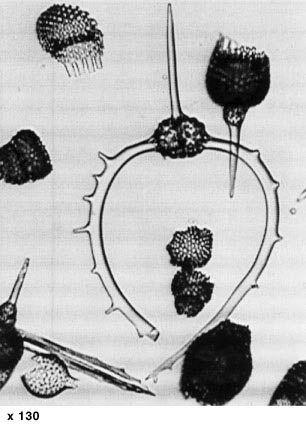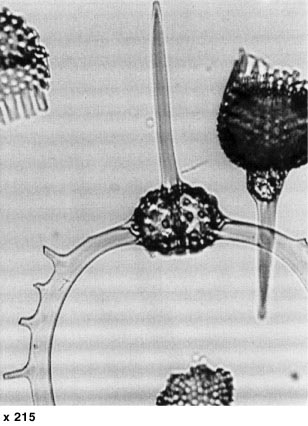 Dorcadospyris
dentata Haeckel
Dorcadospyris
dentata Haeckel Dorcadospyris
dentata Haeckel
Dorcadospyris
dentata HaeckelDorcadospyris dentata Haeckel, 1887, p.1040, pl.85, fig.6; Riedel, 1957, p.79, pl.1, fig.4; Holdsworth, 1975, p.528
Dorcadospyris decussata Haeckel, 1887, p.1041, pl.85, fig.7
Shell subspherical, smooth to tuberculate, with circular or subcircular pores separated by thick intervening bars, bearing a smooth, cylindro-conical apical horn, which is as long to four times as long as shell. Two basal-lateral feet thick, subcylindrical, curved, almost semicircular or sometimes somewhat S-shaped, departing from the shell approximately at right angles, with distal ends approaching, crossing, or fused with one another. Convex side of each foot having a series of usually 4-10 simple conical spines, which vary considerably in their state of development (Riedel, 1957).
Length of apical horn usually 70-230 µm, of shell 60-75 µm, of feet (straight-line distance from proximal to distal end) 250-450 µm, of spines on feet 5-125 µm. Breadth of shell 80-95 µm (Riedel, 1957)
 DISTINGUISHING
CHARACTERS AND PHYLOGENY
DISTINGUISHING
CHARACTERS AND PHYLOGENYLong, stout conical horn. Feet also stout, curved with convexity outward, and bearing thorns on the outer edge (Riedel and Sanfi1ippo, 1978a).
There is a clear evolutionary lineage from Dorcadospyris forcipata to D. alata, with D. dentata as the intermediate form, but the lineage includes a wide range of variation. Through the entire range of these species, the feet vary from semicircular to lyre-shaped (except in the latest part of the lineage, where the lyre-shaped form disappears). In the early part of the lineage there are no thorns on the outer sides of the feet, and these thorns become more prevalent and better developed as time progresses, though toward the end of the lineage they become smaller but persist on almost all specimens. In this present concept of the phylogeny, Dorcadospyris simplex Riedel (1959, p.293, pl.1, fig.10) becomes merged with D. forcipata. The portion of the lineage before the majority of specimens have thorns on the feet is referred to D. forcipata, the middle part of the lineage is D. dentata, and the terminal part, when the majority of forms have lost the apical horn and the lyre shape of the feet, is D. alata (Sanfilippo et al., 1985).
The general shape of the feet varies from semicircular to distally reflexed (in the form of a lyre). Thorns on the outer side of the feet are short in early specimens, long in late specimens. The horn is usually long and robust, but occasionally less developed (Sanfilippo et al., 1985).
This species is more common than Dorcadospyris alata, and has a similar geographic distribution, but in late early Miocene assemblages. Its morphotypic first appearance lies within the Stichocorys wolffii Zone. Its evolutionary transition to Dorcadospyris alata defines the base of the Dorcadospyris alata Zone.
Additional illustrations can be found in Riedel and Sanfilippo, 1971, pl.2D, figs.2-3.
Holdsworth (1975) records several morphotypes of this species and of D. alata.